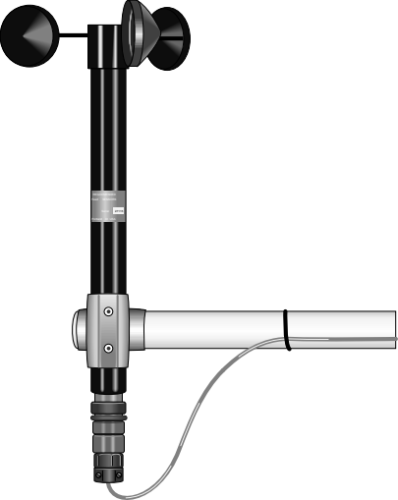All You Need to Find Out About Anemometers: Exactly How They Work, Why They Matter, and Where to Make use of Them
Anemometers, however often ignored in the realm of scientific tools, play a crucial function in numerous areas, providing useful understandings right into wind rate and airflow patterns. As we dig into the ins and outs of anemometer modern technology, we will reveal the inner workings of these gadgets, their significance, and the key factors to consider when choosing the best anemometer for specific applications.

Anemometer Basics
A necessary tool used to determine wind speed and instructions, the anemometer plays a critical duty in meteorology and different industries. An anemometer commonly contains three or 4 mugs that rotate in the wind, a vane that points into the wind, and sensing units to track the rotations or motions. By determining the rotations or movements over a specific amount of time, the anemometer can figure out wind rate. The vane aids identify wind direction by aiming right into the wind, providing valuable data for weather projecting, aviation, maritime operations, ecological surveillance, and wind power applications.
There are different kinds of anemometers available, including cup anemometers, vane anemometers, hot-wire anemometers, and sonic anemometers, each with its one-of-a-kind features and applications. Mug anemometers are generally made use of for fundamental wind speed measurements, while vane anemometers are favored for directional dimensions. Hot-wire anemometers appropriate for reduced airspeeds, and sonic anemometers are excellent for high-precision dimensions in research and industrial settings. Comprehending the fundamentals of anemometers is crucial for precise wind data collection and analysis throughout various industries.
Principles of Anemometer Procedure
Structure on the fundamental understanding of anemometer basics, the principles of anemometer procedure clarify the mechanics behind wind rate and direction dimensions. Mug anemometers, for instance, have three or more mugs that catch the wind, triggering them to spin faster as the wind speed rises. Hot-wire anemometers depend on a heated cord that cools down as wind passes over it, with the rate of cooling figuring out the wind speed.
Importance of Anemometers
The value of anemometers in weather forecasting and different markets can not be overstated. Anemometers play an important role in measuring wind speed and direction, providing necessary data for weather condition projecting, climate research studies, environmental tracking, and aeronautics operations. Meteorologists depend on anemometers to gather exact wind information, helping them comprehend weather condition patterns, predict tornados, and concern timely warnings to the general public. In industries such as building, agriculture, renewable resource, and maritime procedures, anemometers are used to check my reference maximize processes, guarantee security, and raise effectiveness. For instance, wind farm operators use anemometers to analyze wind conditions and maximize electricity manufacturing from wind turbines. In the maritime industry, anemometers help ship navigating by offering real-time wind details to captains, aiding them make notified choices to guarantee secure voyages. On the whole, anemometers are vital devices that add dramatically to safety, performance, and informed decision-making in meteorology and a vast array of markets.
Applications Throughout Various Industries
In the sustainable energy sector, anemometers play a vital function in analyzing wind conditions for wind ranch positionings, making sure optimum energy production. Industries like construction and mining make use of anemometers to keep an eye on wind speeds, essential for safety protocols, especially when functioning at elevations or in open-pit mines where strong winds can present dangers. In agriculture, anemometers aid farmers in taking care of crop splashing by providing real-time information on wind rate to prevent drift.

Picking the Right Anemometer for Your Needs
Choosing the suitable anemometer tailored to your specific needs is vital for acquiring accurate wind see this website rate and instructions measurements. When selecting an anemometer, consider variables such as the intended application, called for measurement range, environmental problems, and preferred features. For general purposes, a mug anemometer appropriates for gauging wind rate, while a vane anemometer offers wind direction information. Hot-wire anemometers are perfect for reduced airspeed measurements, and ultrasonic anemometers use high precision and durability.

Verdict
In conclusion, anemometers play a vital duty in measuring wind rate and instructions across numerous markets. It is vital to consider the relevance of anemometers in order to make informed choices when choosing the most suitable gadget for determining wind conditions.
There are various types of anemometers available, consisting of mug anemometers, vane anemometers, hot-wire anemometers, and sonic anemometers, each with its unique functions and applications. Cup anemometers are commonly made use of for basic wind speed measurements, while vane anemometers are favored for directional measurements. Hot-wire anemometers are ideal for low airspeeds, and sonic anemometers are perfect for high-precision measurements in research study and commercial settings.Structure on the fundamental understanding of anemometer basics, the concepts of anemometer procedure elucidate the see it here auto mechanics behind wind rate and instructions dimensions. For general objectives, a mug anemometer is appropriate for determining wind speed, while a vane anemometer supplies wind instructions data.
Comments on “Anemometer Innovations: The Most Recent Modern Technology for Wind Speed Dimension”